The reproducibility of SfM algorithms to produce detailed Digital Surface Models: the example of PhotoScan applied to a high-alpine rock glacier
- Hendrickx, Hanne Department of Geography, Ghent University, Belgium
- Vivero, Sebastián Institute of Earth Surface Dynamics, University of Lausanne, Switzerland
- Cock, Laure De Department of Geography, Ghent University, Belgium
- De Wit, Bart Department of Geography, Ghent University, Belgium
- De Maeyer, Philippe Department of Geography, Ghent University, Belgium
- Lambiel, Christophe Institute of Earth Surface Dynamics, University of Lausanne, Switzerland
- Delaloye, Reynald Department of Geosciences, University of Fribourg, Switzerland
- Nyssen, Jan Department of Geography, Ghent University, Belgium
- Frankl, Amaury Department of Geography, Ghent University, Belgium - Postdoctoral Fellow of the Research Foundation Flanders (FWO), Brussels, Belgium
-
02.01.2019
Published in:
- Remote Sensing Letters. - 2019, vol. 10, no. 1, p. 11–20
English
In geomorphology, PhotoScan is a software that is used to produce Digital Surface Models (DSMs). It constructs 3D environments from 2D imagery (often taken by Unmanned Aerial Vehicles (UAV)) based on Structure-from-Motion (SfM) and Multi- View Stereo (MVS) principles. However, unpublished computer-vision algorithms used, contain random elements which can affect the accuracy of the outputs. For this letter, ten model runs with identical inputs were performed on UAV imagery of a rock glacier to analyse the magnitude of the variation between the different model outputs. This variation was quantified calculating the standard deviation of each cell value in the respective DSMs and derivatives (curvature). Places with steep slope gradients have considerably more DSM variation (up to 10 cm) but stay within the range of the model’s accuracy (10 vertical cm) for 88 – 96% of the area. The edges of the model also show a larger variability (0.10 – 3 m), related to a lower number of overlapping images. These results should be accounted for when performing a geomorphological research at centimetre scale using PhotoScan, especially in areas with a complex relief. Using medium-quality runs, additional oblique viewpoints and respecting a minimum of five overlapping images can minimize the software’s variations.
- Faculty
- Faculté des sciences et de médecine
- Department
- Département de Géosciences
- Language
-
- English
- Classification
- Earth sciences
- License
-
License undefined
- Identifiers
-
- RERO DOC 324107
- DOI 10.1080/2150704X.2018.1519641
- Persistent URL
- https://folia.unifr.ch/unifr/documents/307520
Statistics
Document views: 155
File downloads:
- pdf: 271
